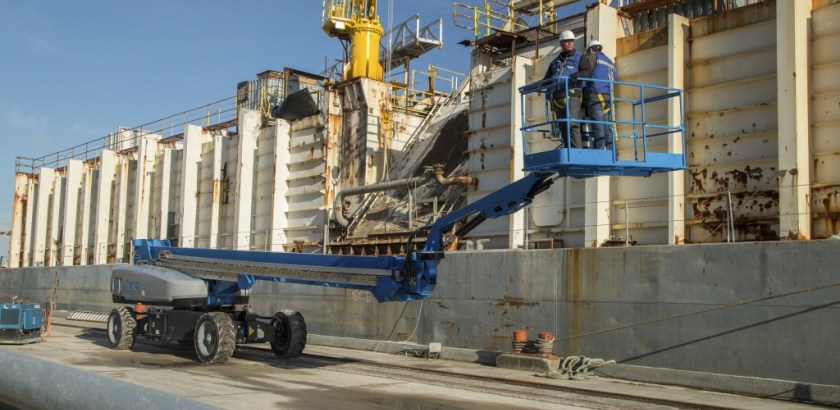What You Need to Know About the ANSI/ITSDF B56.6 Revision
 In May 2016, the US safety standard for Rough Terrain Forklifts, ANSI/ITSDF B56.6, was revised. As this standard is also referenced in the Canadian standard CSA B335, effectively this revision affects all North American manufacturers, owners, users and operators of Rough Terrain Forklifts. It’s important to understand these changes as they relate to your rental business and to start reviewing with your current practices to help ensure that you are compliant with the standard when it becomes effective on May 20, 2017.
In May 2016, the US safety standard for Rough Terrain Forklifts, ANSI/ITSDF B56.6, was revised. As this standard is also referenced in the Canadian standard CSA B335, effectively this revision affects all North American manufacturers, owners, users and operators of Rough Terrain Forklifts. It’s important to understand these changes as they relate to your rental business and to start reviewing with your current practices to help ensure that you are compliant with the standard when it becomes effective on May 20, 2017.
Changes to the standard occurred in the following sections:
- 15 – Elevating Personnel
- 2 – General
- 5 – Operator Care of Rough Terrain Forklifts
- 10.5 – Load Handling Symbols
- 15 – Protective Structures
- 24 – Personnel Work Platforms for Elevating Personnel
- Part IV Glossary of Commonly Used Words and Phrases
Let’s walk through some of these changes…
Section 5.15 – Elevating Personnel (User)
This section underwent a major revision. Some of the major changes for users are:
- Only use platforms if approved by forklift manufacturer.
- Do not exceed the load capacity chart or the capacity shown on the information plate.
- More user and operator requirements for platforms equipped with controls.
- Means of communication between the platform occupant and the forklift operator.
- Fall arrest may be required.
Section 6.2 – General (Operator)
This section also underwent a major revision. Some of the major changes for operators are:
- Pre-operation inspection required.
- An initial worksite hazard assessment as well as continuous monitoring for hazards is required.
- Maintain minimum clearance from energized powerlines.
Section 6.5 – Operator Care of Rough Terrain Forklifts (Operator)
The biggest changes are:
- More details have been added to the pre-operation inspection list.
Section 8.10.5 – Load Handling Symbols (Manufacturer)
- Load handling symbols now reference ISO 3287 and ISO 7000.
Section 8.15 – Protective Structures (Manufacturer)
- Roll Over Protective Structures (ROPS) will be required to be certified to ISO 3471 for compliance. Table three was updated, changing 610 mm to 600 mm.
Section 8.24 – Personnel Work Platforms (Manufacturer)
This section has been completely rewritten to help align with the same performance criteria in the ISO 16368 aerial lift standard.
Some of the major changes for the design of the work platforms are:
- Structural safety factor has been added for non-ductile materials.
- Steps, or ladder, are required if the distance from the ground to the work platform exceeds 16 in (400 mm).
- Minimum toe board height is now 6 in (150 mm) but may be reduced to 4 in (100 mm) at the entry points.
- If gates are provided they need to open inward and have a positive self-latching mechanism.
- Each guardrail and midrail needs to be able to withstand a 225-lb (1,000 N) load in any direction without permanent deformation.
- Fall protection anchorages are now required and each shall withstand a static load of 3,600 lb., for each person allowed to connect simultaneously, without reaching its ultimate strength.
- A weather resistant compartment for storing the manufacturers work platform manuals/instructions is now required.
- Load charts are now required for the work platform and rough terrain truck combination.
- More defined requirements have been provided for work platforms equipped with controls.
- New marking requirements for the work platform.
- New stability requirements for the work platform rough terrain truck combination, including an arresting fall simulation.
Part IV Glossary of Commonly Used Words and Phrases
New definitions have been added/revised:
- Reach mechanism.
- Unattended and attended rough terrain trucks.
 In conclusion, just about every entity involved with the manufacture and operation of the Rough Terrain Forklift are affected by these new changes. These changes will have a positive impact on the safe use of these products across the industry. It’s important to note that many of the changes can have a significant impact to your organization, so identifying these potential challenges and resolving them before the effective date is critically important.
In conclusion, just about every entity involved with the manufacture and operation of the Rough Terrain Forklift are affected by these new changes. These changes will have a positive impact on the safe use of these products across the industry. It’s important to note that many of the changes can have a significant impact to your organization, so identifying these potential challenges and resolving them before the effective date is critically important.
As this standard is available free of charge through www.itsdf.org, I encourage you to download a copy to get more detailed information to help with that review.
Related Posts

Changes to the ANSI and CSA Standards You Need to Know About
The current ANSI and CSA standards for safe use and training have not been updated for many years (the current ANSI boom, scissor lift and manually propelled standards were last updated in 2006, and CSA standards go back even further).
Continue Reading

Addressing the Challenges of the Upcoming Changes to the ANSI A92 Standards
The upcoming implementation of the new ANSI A92.22 Safe Use and A92.24 Training Standards for Mobile Elevating Work Platforms (MEWPs) in the United States is creating quite a bit of confusion in the industry. T
Continue Reading


